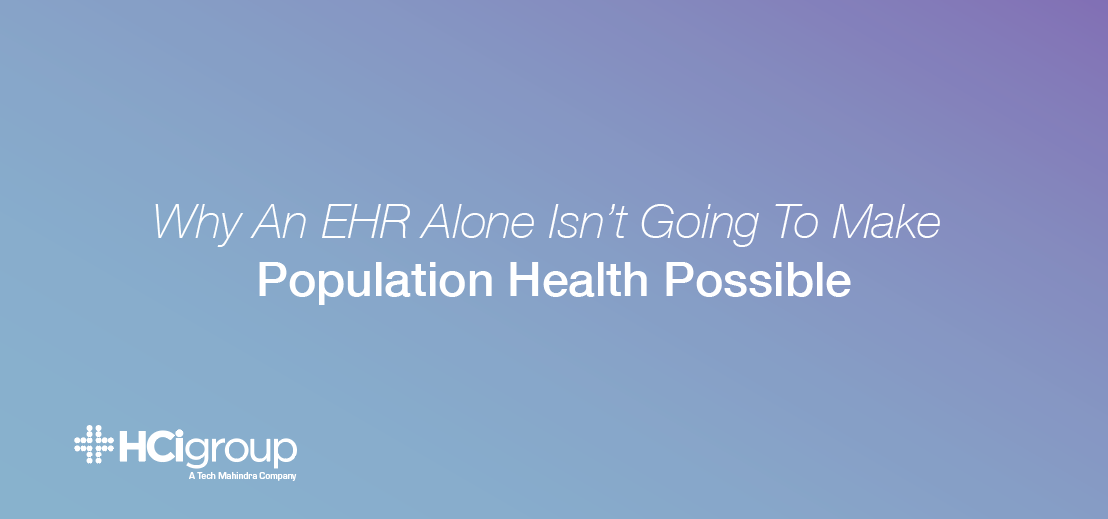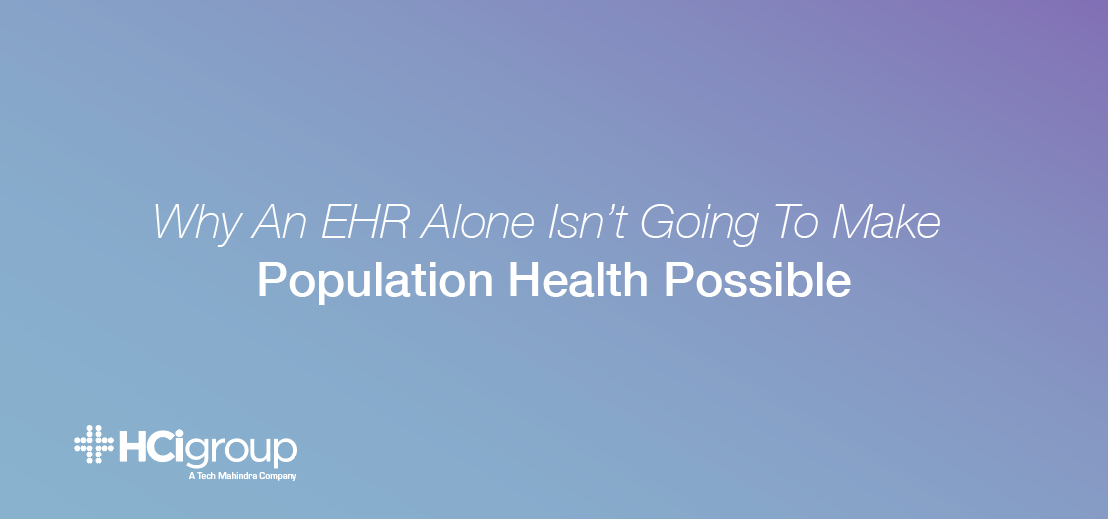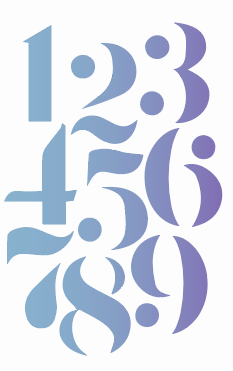Why An EHR Alone Isn’t Going To Make Population Health Possible


With the rise in focus on population health by large health systems and hospitals, many executives and stakeholders are left scratching their heads to understand why the epic (no pun intended) investment in their EHR isn’t getting the job done. The reality is that most EHR systems were designed for the Fee-For-Service days, and there simply aren’t quick enough adaptations in those technologies to address the vital importance of tracking patient outcomes, not just codes. We’ve seen clients point to their behemoth health records system as the solution to a myriad of patient management problems, but it takes a comprehensive approach to healthcare technology to leverage (not lean on) an established EHR to make population health management possible.
Today we’ll discuss a few “value-add” opportunities to better support population health initiatives for a health organization, with an understanding that EHRs can be part of the solution, but not the smoking gun. (Though if you’ve ever felt like your technology did, in fact, shoot you in the foot, you’re not alone. But that’s another post for another day.)Know Your Numbers...Then Visualize Them For Better Population Health
Keeping tabs on progress when it comes to pop health interventions is often a numbers game. Sure, your Epic system, for example, may contain a wealth of data to leverage when it comes to taking the temperature (again with the puns…) on  how patient management is going, but if there is no effective way to visualize that data, it’s not likely serving the stakeholders and administration. Having the data in a logical place, updated often, and distilled into actionable facts is what allows health systems to move the needle on population health progress and improve patient outcomes.
how patient management is going, but if there is no effective way to visualize that data, it’s not likely serving the stakeholders and administration. Having the data in a logical place, updated often, and distilled into actionable facts is what allows health systems to move the needle on population health progress and improve patient outcomes.
There are many dashboarding and visualization tools for health organizations, both for the IT infrastructure supporting the otrg, as well as the patient data driving revenue and supporting contracts/partnerships. In our experience, Leadership doesn’t want a packet of data or rainbow-colored charts; they want stoplights, metrics, and growth indicators. Don’t reinvent the wheel here, but bolting on a visualization solution can help make data residing within the EHR actionable and incredibly powerful.
Tap Into Technology Designed To Track And Measure Patient Care Outcomes
Speaking of bolt-on solutions, it can be well worth your while to tap the insight of healthcare IT consultants who are well versed in population health. They can recommend and help implement solutions that are designed to augment an EHR and provide more value, specifically in the following areas:
- Case Management
- Clinical Workflow Design
- Patient Engagement
- Predictive Analytics
Generally speaking, one-size-fits-all solutions underdeliver. It’s wiser to opt for several solutions that are expertly designed and developed to solve a specific problem, than one piece of technology that does many things mediocrely. But, you can also cause your system to crash to a screeching halt if you don’t integrate those “low impact” tools well, so hire the right folks and get cranking on patient care. That’s what counts.
Shift The Mindset Of Your Health System Team
Admittedly, this isn’t a task than can be accomplished by healthcare technology or your EMR. However, when health systems take the time to educate their whole staff and physician team on why changes are being made, on how the leadership team intends to measure and impact patient outcomes, and on what individuals can do to contribute to the bigger picture, it goes a long way in facilitating buy-in. Especially when leadership is trying to implement new processes or change up workflows (whether within the EHR or just in practice), it’s critical that resources can tie effort to population health goals.
team intends to measure and impact patient outcomes, and on what individuals can do to contribute to the bigger picture, it goes a long way in facilitating buy-in. Especially when leadership is trying to implement new processes or change up workflows (whether within the EHR or just in practice), it’s critical that resources can tie effort to population health goals.
To facilitate this needed mindset shift, hospital leaders can:
- Celebrate progress
- Communicate well (concisely) and often (keep your finger on the pulse...oy, the puns)
- Loop technology partners into company initiatives
- Part ways with technology, resources, or initiatives that don’t serve core vision
- Set clear, measurable goals
Because the focus of population health is to improve the wellness of a given community of patients, a healthcare IT strategy must incorporate some of the “touchy-feely” elements, not only for patients, but also for their care team. This will encourage a holistic system that is focused on people first, utilizing effective technology to do the job well.
